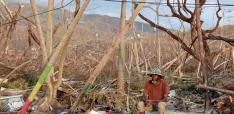In Solidarity with Black Lives Matter, the Development Sector Must Reform

Shmona Simpson argues that to truly stand in solidarity with #BLM, the development sector must work towards its own irrelevance.
After four weeks of global Black Lives Matter protests sparked by the murder* of George Floyd; world leaders and big business alike have published their commitments and strategies to combat anti-black racism.
We have yet to see comment or commitment from the international health and development sector.
This seems ironic. The faces of Black women and children in brightly coloured fabrics decorate these agencies’ websites, presentations, and – importantly - calls for funding. We are all too familiar with the agonizing television advertisements featuring Black women, holding wailing babies, in squalid conditions. They remind us that for the price of our daily cup of coffee, we too, can change their lives.
Behind this black-lives-matter store front, are white majority corporate entities accused of spending the bulk of their endowments on high salaries; reporting low satisfaction among their black African staff; and providing token funding for programmes led by Black African people. Sometimes even in humanitarian crises, only nominal funding reaches those for whom it was intended. It seems strange that the money raised in the name of Black women and children is not spent by them. But this concept is not new.
A sector reared on the Subhuman
After the 4 year genocide of 6 million Jews by Nazi-Germany, over $10bn in reparations was rightly paid by the German Government and corporations who benefitted from their labor. After 500 years of the African Holocaust encompassing chattel slavery, settler colonialism, apartheid, Jim Crow, and persistent racial terrorism, impacting over 1bn continental and diasporic Africans: Europeans and Americans have never paid up. In fact, they created what I call the “First Black Debt”.
The French extorted $21bn from Haiti as reparations for the loss of their slave colony following emancipation. The “liberated” African Americans never got their forty acres and a mule: rather, wage labor was the order of the Reconstruction era, disadvantaging the ownership of their own land to this day. Slavery in the Caribbean continued for an additional 6 years after emancipation to compensate slave owners for their “chattel”.
Some feel these debts are reasonable: whites built the roads, schools, and hospitals providing civilization for Black people. The reality is that the infrastructure was built using forced Black labour, fuelled by propaganda that Blacks were subhuman, and was never intended for Black Africa or her diaspora to thrive.
Roads were built to move goods from mines/plantations to ports for the benefit of colonial powers. Hospitals and schools were for the benefit of the white minority, not built with the black majority in mind. There was as much as 80% illiteracy when England left its Caribbean colonies. Africans both continental and diasporic, began their “freedom”- in the red.
On this legacy, and the Black struggle for reparations, the aid and development sector are silent.
Yet, they have been vocal about the Black neocolonial ruling class leaving their own people behind as they quietly slipped into the positions vacated by the colonial masters. They blame Black corruption for creating the enduring misery of Black poverty, forcing the aid and international development industry to fill the gap.
Yet, it has been reported that more money leaves Africa than goes in. Scholars have argued that aid and development loan instruments have done more harm than good. This money is not a handout. These interest-bearing loans with strings attached have not only saddled the post-colonial children with a “Second Black Debt” but served the corporate interests of outsiders. They even argue that vertical and siloed health programmes designed for quick wins may be sustaining the fragility of Africa’s health systems.
It seems strange that international health and development agencies are headquartered in the West; tightly gripping the innovation process, jobs, and money. But the development sector has normalized this process for Black lives, entrenching the belief that Black people and nations remain immature- incapable of compassion for their fellow man or governance. White supremacy has latched on, and amplified this posturing, entrenching a second subhuman status for Black lives, continuing down a road to hell paved with good intentions.
Racism is the virus, disparities are the symptoms
The intersection between race and health has recently been highlighted by the COVID-19 pandemic. However, public health experts have always known that the life expectancy of African Americans trends lower than white Americans. The genesis of this is like what Black people experience in all post-colonial, post-slavery and post-apartheid settings: following segregation and redlining, African Americans predominantly live in areas where there is worse education, poorer living condition, and high exposure to toxic environmental substances. For every $1 of white wealth, African Americans have 10 cents.
If income and education are key indicators for good health, COVID-19 disparities impacting Black populations are not surprising (not surprising in Brazil, or Britain, or South Africa). What is hard to accept, is that African Americans who achieve wealth and education are still at risk. Black college graduates who avoid social determinants of poor health, will still die before white people who only attain high school degrees. Apparently, income and education are not enough. Why? Racism.
David Williams created the “everyday discrimination scale” and demonstrated that African Americans who experience microaggressions have higher rates of cardiovascular disease, cancer, and low-birth rate. African women who migrated to America have maternal and infant mortality rates on parallel with their white counterparts. Their daughters do not: they are more likely to give birth to sick babies and die themselves. This difference was attributed to the weathering that occurs within one generation of exposure America’s systemically racist environment.
It is frightening to think what the multigenerational impact on health could be, especially when compounded with the effect of racist healthcare providers who provide Black patients less access to testing and worse care. It is no wonder there remains poor engagement between Black people and the healthcare system. It would be difficult to trust the clinical academe that experimented on them for hundreds of years, providing the economic and clinical material to fuel advances in Western medicine, while they were left to die disproportionately and without compensation.
In this regard, Black trust in the international health and development industry is no different. Global health was reared and continues to feed on a similar practices, where Black Africans provided the clinical material, systems, economies and psyches to test the world’s interventions. This is why it was so easy for French scientists to casually suggest that “no masks, no treatments, no resuscitation” [in Africa] provided an ideal testing ground for coronavirus vaccines- like “studies on AIDS in prostitutes.”
The reality is that everywhere Black people are in this world, they are enduring “everyday discrimination,” drowning in the unfairness of the global white supremacist system and the mounting psychosocial and economic debt they owe for their own freedom. The “Third Black Debt” is imminent: the pandemic threatens to erode decades of progress, prompting more loans to be taken at a time of little economic productivity. Some economies will be forced to re-open not because people are bored, but because people will starve. These Black lives lost to COVID-19 will be the reckoning for hundreds of years of health and income disparities, compounded generation after generation.
The international development industry began with the tremendous need, but without much input from, the people it intended to serve. In doing so, it has established a system and discourse that perpetuates the very inequalities it aims to address. Meanwhile, the impact of white supremacy becomes more and more entrenched, and harder to see.
We can no longer see the intersection between the colonial distribution of arable land, food insecurity and poor health in some parts of Black Africa. We forget that the creation and endurance of townships drives the tuberculosis epidemic in South Africa, and that perhaps urban planning and architecture may be more impactful than new drugs. We are not discussing how segregation, the stress of racial terrorism, and generations of failed interaction with the healthcare system is allowing SARS-COV-2 to disproportionately wipe out African Americans. In all this obfuscating, we have failed to realize that reversing these manifestations of negrophobia are key to solving health and development disparities.
Assistance as Justice- A new perspective on our work
After #BLM, all institutions working for a fairer world must internally reflect on these legacies, and ask themselves how they impact the positions they hold personally, their position in the world institutionally, how they treat each other, who they fund, and how they work. They should reflect on whether they are sustaining a system of their own relevance, or truly working towards an independent future where Black lives may have their full humanity and autonomy reinstated.
It is difficult for any industry to work towards the annihilation of itself. However, there are small steps it can take in true service of the people whom they represent.
Majority white agencies operating on behalf of Black lives desperately need an oversight committee of the people they claim to serve. This is not simply to address the decades of delegitimizing Black agency but to measure success based on the lived experience. Beware! These committees need not only technocrats, but activists and civil rights leaders with a commitment to reparative justice. For too long, technical breadth and depth have been the sole criteria for a career serving Black lives.
It should not be taboo to include the beneficiaries of these programs in decision making. Is the industry today prepared to bring the same poor Black women whose photos decorate their websites, to their corporate offices and give them the vote? How many staff feel comfortable living and working among communities they claim to serve? Not many: the segregation of expatriates inside gated communities with substantially more compensation than their local counterparts signals this loud and clear.
Representation will not be enough: the tool-based model of international health and development is quickly becoming outdated. This sector is full of well-meaning and brilliant people of all races who devote their lives to reducing poverty and inequity. I cannot stress enough that stigma reduction, water and sanitation, agricultural innovation, diagnostics, vaccines, and therapeutics have saved millions of Black lives. But, it is time for the industry to realize that the problem is also about the “10 cents on a dollar.”
Agencies who work on behalf of Black lives, subsist on the crumbs falling off the tables of Governments, billionaires, and the generosity of people who donate to charities. Solely supporting this model means they will always be playing catchup.
The real solution is reparative justice, which must include a psychosocial rehabilitation of the enduring negrophobia, and direct giving- allow those affected to set the agenda of how the money is spent. At a very small scale, the industry can begin to reconsider whether the Black-lives-matter initiatives they support will be endorsed by Black people at all levels and evaluated by the full realization of Black potential. At its most comprehensive, the industry should consider a reparative justice lens: one that moves away from measuring quick gains won by tools, to one based on generational repair, with 25-50-year strategies that end in autonomy and transferal of ownership.
Racial terrorism, health and development disparities thrive on the global subhuman status of Black life. For this to change, the development sector must do more to root out negrophobia from its structure and operating practices. It must envision a world where racism, and the resulting health disparities are impossible.
It must work towards its own irrelevance.
And, it can.
The continued silence of the international health and development industry is troubling. Either this moment of global reckoning caught them unprepared, or they think they are doing enough already: both are unacceptable. Without drastic change, it is only a matter of time before another manifestation of Black Lives Matter including the youth in Africa and the African diaspora is at the door of this sector. They will demand that no more money be raised in their name unless it truly engages, relieves, and empowers them.
Shmona Simpson is an international health advisor, specializing in infectious disease R&D. She works to strengthen systems, catalyze and democratize translational research. She studied Global Health and Clinical Immunology at Oxford, where she was Chair of the Black Rhodes Scholars Association. The views expressed are solely her own.
*This article was updated in May 2024 with the word murder (previously tragic death) to reflect the conviction ruling.
Photo by Life Matters from Pexels


